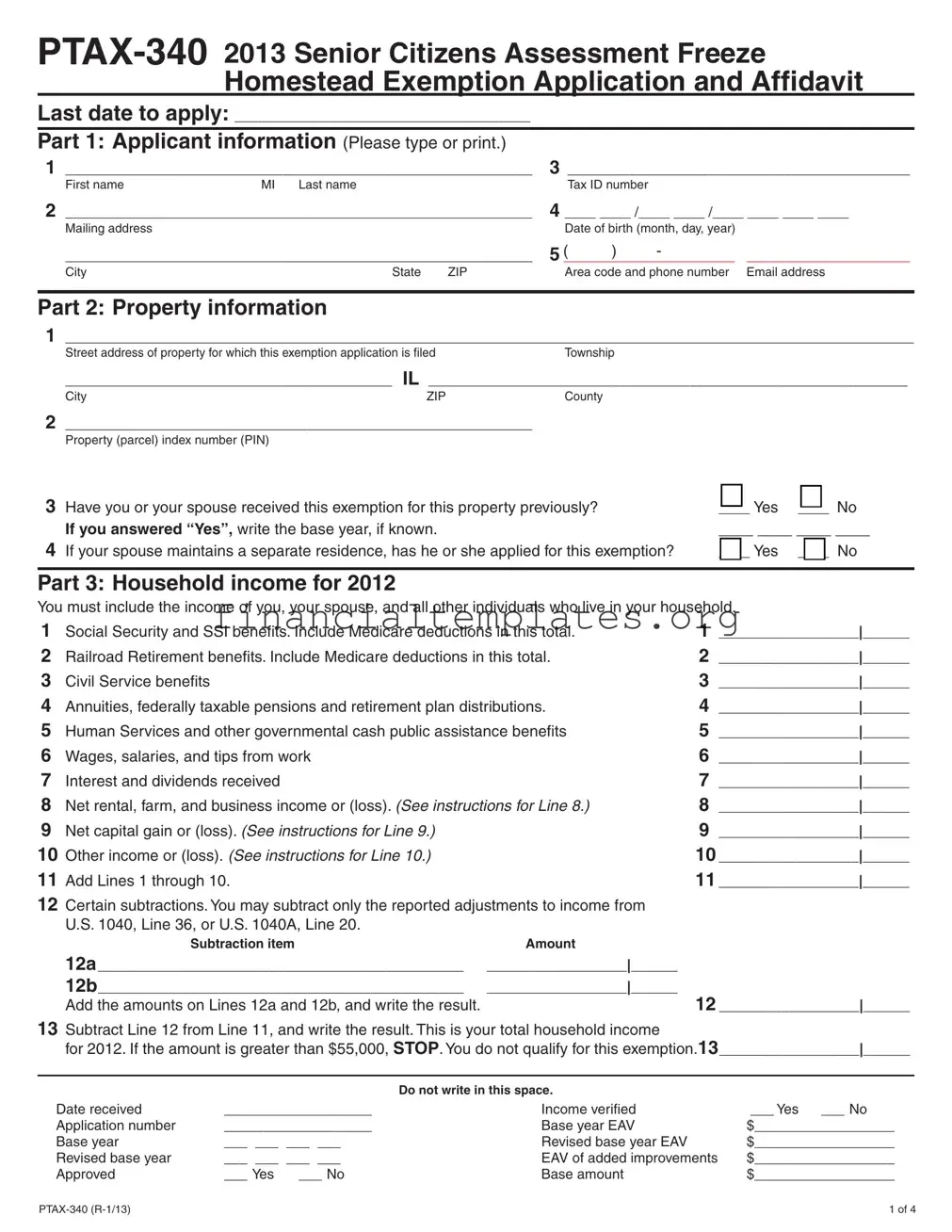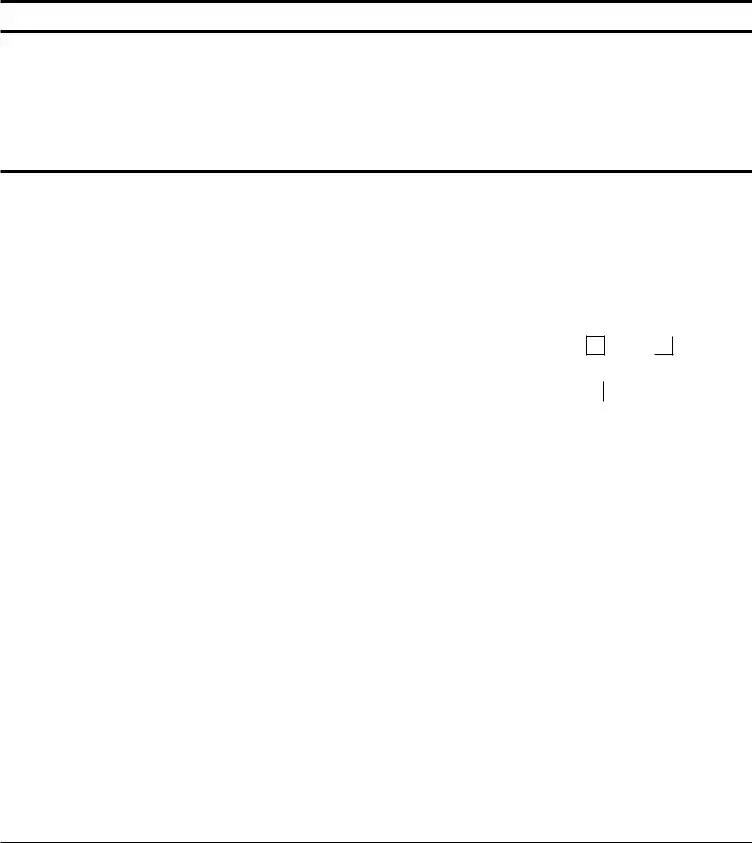Part 1: Applicant information
Lines 1 through 5 — Type or print the requested information.
Part 2: Property information
Lines 1 and 2 — Identify the property for which this applica- tion is filed.
Lines 3 and 4 — Answer the questions by marking an “X” next to your statement. If you answered “Yes” to the question on Line 3 and you know the base year, write it in the space provided.
Part 3: Household income for 2012
“Income” for this exemption means 2012 federal adjusted gross income, plus certain items subtracted from or not included in your federal adjusted gross income (320 ILCS 25/3.07). These in- clude tax-exempt interest, dividends, annuities, net operating loss carryovers, capital loss carryovers, and Social Security benefits. Income also includes public assistance payments from a govern- mental agency, SSI, and certain taxes paid. These Step-by-Step Instructions provide federal return line references and reporting statement references, whenever possible.
The amounts written on each line must include the 2012 income for you, your spouse, and all the other individuals living in the household.
Line 1 — Social Security and Supplemental Security Income (SSI) benefits
Write the total amount of retirement, disability, or survivor’s benefits (including Medicare deductions) the entire household received from the Social Security Administration (shown on Form SSA-1099, box 3 or use box 5 only if there is a reduction of ben- efits). You also must include any Supplemental Security Income (SSI) the entire household received and any benefits to depen- dent children in the household. Do not include reimbursements under Medicare/Medicaid for medical expenses.
Note: The amount deducted for Medicare ($1,198.80 yearly or $99.90 per month, per person) is already included in the amount in box 3 of Form SSA-1099.
Line 2 — Railroad Retirement benefits
Write the total amount of retirement, disability, or survivor’s bene- fits (including Medicare deductions) the entire household received under the Railroad Retirement Act (shown on Forms SSA-1099 and RRB-1099).
Line 3 — Civil Service benefits
Write the total amount of retirement, disability, or survivor’s benefits the entire household received under any Civil Service retirement plan (shown on Form 1099-R).
Line 4 — Annuities and other retirement income
Write the total amount of income the entire household received as an annuity from any annuity, endowment, life insurance con- tract, or similar contract or agreement (shown on Form 1099-R).
Include only the federally taxable portion of pensions, IRAs, and IRAs converted to Roth IRAs (shown on U.S. 1040, Line 15b and 16b, or U.S. 1040A, Line 11b and 12b). IRA’s are not taxable when “rolled over,” unless “rolled over” into a Roth IRA.
Line 5 — Human Services and other governmental cash public assistance benefits
Write the total amount of Human Services and other governmen- tal cash public assistance benefits the entire household received. If the first two digits of any member’s Human Services case num- ber are the same as any of those in the following list, you must include the total amount of any of these benefits on Line 5.
01 |
aged |
04 and 06 temporary assistance to |
02 |
blind |
needy families (TANF) |
03 |
disabled |
07 general assistance |
To determine the total amount of the household benefits, multi- ply the monthly amount each person received by 12. You must adjust your figures accordingly if anyone in the household did not receive 12 equal checks during this period.
Food stamps, medical assistance, and Circuit Breaker benefits anyone in the household may have received are not considered income and should not be added to your total income.
Line 6 — Wages, salaries, and tips from work
Write the total amount of wages, salaries, and tips from work for every household member (shown in box 1 of Form W-2).
Line 7 — Interest and dividends received
Write the total amount of interest and dividends the entire house- hold received from all sources, including any government sources (shown on Forms 1099-INT, 1099-OID, and 1099-DIV). You must include both taxable and nontaxable amounts.
Line 8 — Net rental, farm, and business income or (loss)
Write the total amount of net income or loss from rental, farm, business sources, etc., the entire household received, as allowed on U.S. 1040, Lines 12, 17, and 18. You cannot use any net oper- ating loss (NOL) carryover in figuring income.
Line 9 — Net capital gain or (loss)
Write the total amount of taxable capital gain or loss the entire household received in 2012, as allowed on U.S. 1040, Lines 13 and 14, or U.S. 1040A, Line 10. You cannot use a net capital loss carryover in figuring income.
Line 10 — Other income or (loss)
Write the total amount of other income or loss not included in Lines 1 through 9, that is included in federal adjusted gross income, such as alimony received, unemployment compensation, taxes withheld from oil or gas well royalties. You cannot use any net operating loss (NOL) carryover in figuring income.
Line 11 — Add Lines 1 through 10.
Line 12 — Subtractions
You may subtract only the reported adjustments to income totaled on U.S. 1040, Line 36 or U.S. 1040A, Line 20. For example
• |
IRA deduction |
• Educator expenses |
• |
Archer MSA deduction |
• Tuition and fees |
• |
moving expenses |
• Domestic production |
• |
alimony or maintenance paid |
activities deduction |
• health savings account deduction
•student loan interest deduction
•jury duty pay you gave to your employer
•one-half of self-employment tax
•self-employed health insurance deduction
•self-employed SEP, SIMPLE, and qualified plans
•penalty on early withdrawal of savings
Line 13 — Total household income
Subtract Line 12 from Line 11. If this amount is greater than $55,000, you do not qualify for this exemption. See Page 3.
Part 4: Affidavit
Lines 1 through 4 — Mark the item that applies. Read the af- fidavit carefully. The statements must apply.
Line 7 — Write the names and tax identification numbers of the individuals, other than yourself, who used the property for their principal residence on January 1, 2013. Attach an additional sheet if necessary.
Line 8 — Follow the instructions on the form. If your spouse does not reside at this property, be sure to write his or her name and address.
Note: You must sign your Form PTAX-340 and have it notarized before you file it with your CCAO. Return your completed Form PTAX-340 to your CCAO’s office or mail it to the address printed on the bottom of Page 2.




